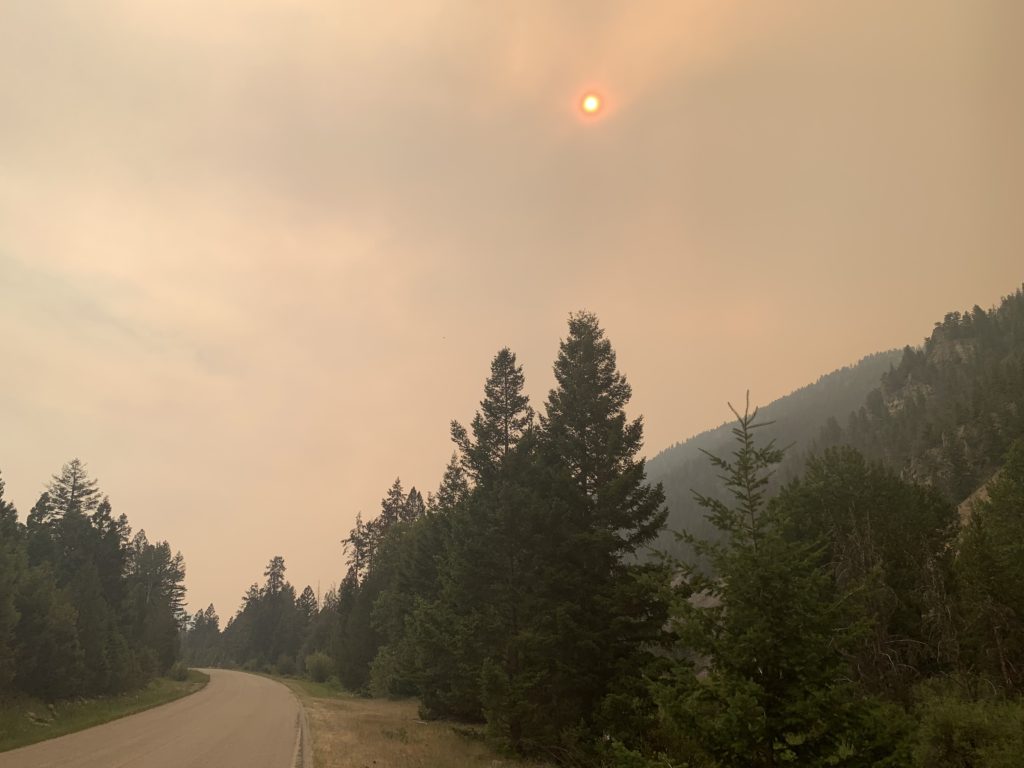
Even though it’s mid-day, it’s eerily dark outside. Since the light is so diffuse, there are no shadows on the ground. I’m biking up a steep mountain trail in central Montana and, through the smoke from a nearby fire, the sun is deep orange. It burns my throat and nostrils, but the larger effect is psychological — the smoke and haze are strangely oppressive, making me feel almost claustrophobic. I’m in Big Sky Country and normally would be able to clearly see neighboring mountain ranges over a hundred miles away, but these conditions shrink the world down to a landscape of a less than a kilometer. People that have experienced similar climate-driven conditions in recent years often use the word “apocalyptic” and that’s exactly what it feels like —a hot, dry, smokey, orange-tinted scene from Blade Runner. That was the summer of 2021 in the western United States.
How did I get here?
Big mountains and the high sage bush deserts of the American west aren’t my native habitat. I’m a marine ecologist and most of my fieldwork is on Caribbean coral reefs or the productive, rocky reefs of the Galapagos Islands. I work underwater in tropical seas surrounded by fishes, corals, and seaweeds. But I also love the mountains and alpine ecosystems and I’ve always been crazy about bikes. I’ve raced BMX, mountain, and road bikes since I was a kid. I worked as a bike mechanic and a bike messenger in my 20s. And last summer (unable to get to my field sites due to COVID), I got back into bikepacking; essentially backpacking on a mountain bike.

All my gear (clothing, food, my stove and tent) is stored in waterproof bags and strapped to my bike’s frame and handlebars. It makes for a heavy load, but also total freedom to explore and experience the terrestrial world. Peddling for hours (some days 10+) might sound grueling, but once you adapt to it, the repetitive motion is very Zen, healing, and surprisingly addictive. If the conditions are right, I can travel 50 or even 100+ miles in a day. Most days, I’ll cross a mountain pass or two and a dozen clear streams. I will ride across numerous ecotones and will see an abundance of wildlife. And I’m always on the lookout for grizzly bears and mountain lions. On journeys like this, your inner conversation gets mostly constrained to the essentials; the trail, wildlife, water, food (lots of pop tarts!) and where you’ll camp that night. At the nucleus of our existence, that’s really about all we’re meant to think about.
I was riding on the 2,700 mile “Great Divide Mountain Bike Route” that runs from Banff National Park in Canada all the way down to southern Arizona and the Mexican border. There are some rural, paved roads, but mostly you’re alone and on trails and gravel roads through the forest and across massive, open valleys. It’s an incredible way to experience the landscape and to meet the people that live in it. Unfortunately, it is also how you experience climate change firsthand.

Rocky Mountain climate catastrophe
When I started the trip just outside of Glacier National Park it was 35°C (95°F). The previous week it was 41°C (110°F). In northern Montana! Summertime temperatures in this region have increased by 2.5°C (4.5°F) since 1970. The science of climate attribution has advanced rapidly, and it is now known with substantial certainty that these heatwaves and the hot, dry, windy weather that promotes wildfires have become far more common due to climate change. According to the new IPCC climate report extreme heat and fire will continue to intensify as the concentration of carbon dioxide and other greenhouse gases in the atmosphere increases. Of course, it’s not only the western US and Canada; these conditions are developing in many other regions (e.g., Siberia, Paraguay, and Australia).

The smoky conditions I faced weren’t unexpected. A lot of people riding the trail last summer lamented about them on social media, and I’ve read and co-authored enough climate change reports to know that this really is our new normal. I’d thought (or hoped) I could avoid the worse by starting relatively early (on July 4), but fire season in the western US is beginning earlier and lasting longer. I felt awful for the millions of people who live with the smoke for months every summer. It’s terrible for their physical and mental health. In fact, a recent joint statement published simultaneously in hundreds of medical journals stated, “The greatest threat to global public health is the continued failure of world leaders to keep the global temperature rise below 1.5° C and to restore nature” [1].
Now I’m back in Chapel Hill (North Carolina, USA) and its hurricane season. Across much of the U.S., it’s increasingly too much water that’s the problem. Category 4 Hurricane Ida just flooded Louisiana. Three days later, flooding from the storm’s remnants resulted in 45 casualties in New York and New Jersey. This summer, record rainfall events have killed dozens of people in Tennessee, Kentucky, and North Carolina and nearly one in three Americans experienced a weather disaster [2]. Scientists have been warning about weather extremes for years as an important aspects of climate change. These catastrophic weather events will continue to intensify as greenhouse gas concentrations increase.

It wasn’t always smokey on the trip. If the wind was blowing in the right direction, it would clear out the smoke from local fires and wouldn’t bring in smoke from distant fires in California and Oregon. But there was another omnipresent reminder of climate change: mass tree die offs caused by drought and heat. [3,4]. Most days I’d pass through at least one relic forest, where nearly all the trees covering a whole mountainside were dead. Some of the standing dead had also burned, creating a stark, Mordor-esque landscape. The conifers that blanket the mountains of the west, particularly spruce and pine, are being killed off by bark beetle outbreaks exacerbated by global warming. Additionally, a recent study 38 year study in Colorado found that the changing climatic conditions alone was the primary cause of tree mortality. These die offs also fuel wildfires and release massive amounts of carbon stored in the trees when they burn; a perverse positive feedback that intensifies the cycle of ecosystem degradation.
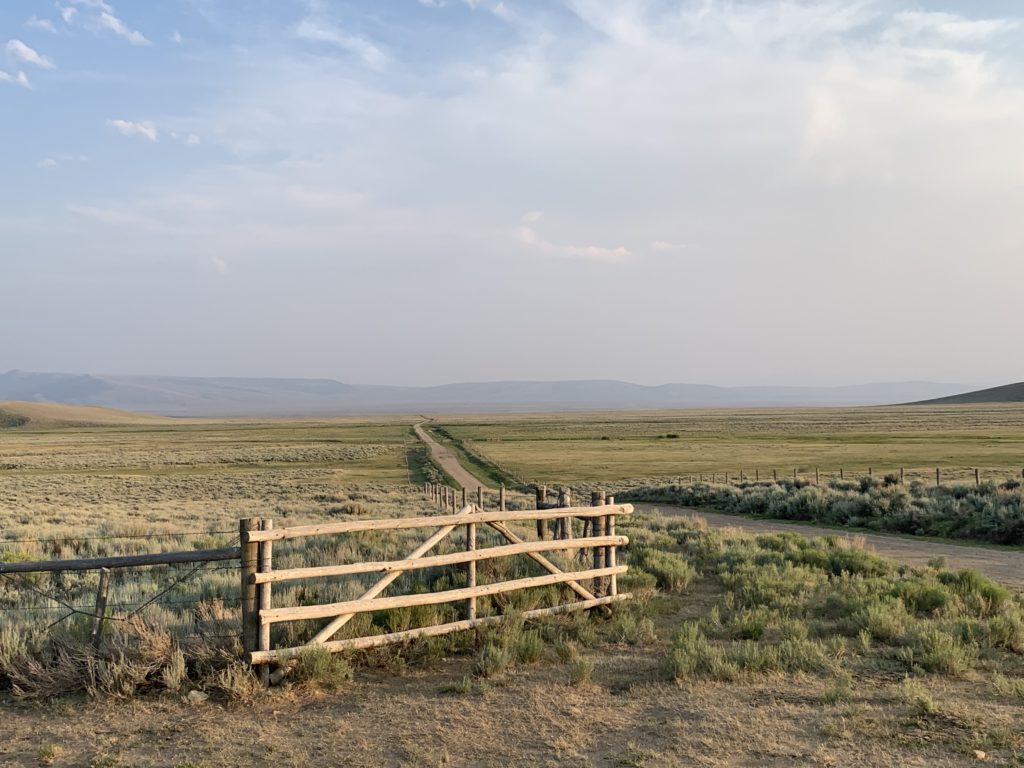
Ocean heating and coral reefs
Although it was jarring to experience climate change in the terrestrial world, I’ve been observing (and documenting) similar impacts in the ocean for nearly a quarter century. The mass-die offs of trees in these high elevation forests was a constant reminder of the loss of foundation species in the ocean that I study. A lot of the work in my lab is focused on the corals that build-up Caribbean reefs. These colorful and biodiverse edens of the world’s tropical seas are obviously different from mountainous conifer forests, yet I see parallels in how these habitats are being degraded by climate change.
Corals are invertebrate animals in the phylum Cnidaria (closely related to jellyfishes and sea anemones). These tiny animals have built up Caribbean reefs over the last few thousand years, through the slow accumulation of their calcium carbonate skeletons. The gigantic structures they create are occupied by thousands of other species that couldn’t survive without a refuge from predators like sharks and barracuda. Ecologists call these habitat-forming organisms “foundation species.” Trees fill the same role in forests. When corals and trees die off, the loss cascades through the ecosystem, and countless other species subsequently disappear. Diverse, vibrant ecosystems are wholly dependent on dense, healthy populations of these and other foundation species.
The jarring reality is Caribbean reefs have lost more than half of their reef-building corals over the last 25 years. On many of the reefs I study, nearly all of the coral is gone and the seafloor is now covered by seaweeds, sponges, bacterial mats and other critters. Like tree die offs, the Caribbean’s corals are being killed off primarily by diseases, many of which are caused or at least enhanced by ocean warming. Some corals also simply can’t stand the heat and are killed directly when water temperatures exceed their thermal tolerance (a phenomena called “coral bleaching” by reef scientists).

Climate winners and losers
Some coral species are more sensitive to climate change than others. But unfortunately, like in the mountain forests I cycled through, the massive, long-lived foundational species seem to be much more sensitive than the small, weedy species they are being replaced by. The weedy plants and corals can’t fill the same ecological role as the trees and massive corals that have dominated these ecosystems since before humans evolved.
While some species are clearly harmed by climate change, others can benefit from it. For some types of organisms (e.g., corals and trees) it appears to be the large, long-lived ones that are more susceptible. In some cases, it’s because they’re more physiologically sensitive to environmental change. But other times species that are climate change “winners” are equally sensitive but have a greater capacity to repopulate areas after a climate disturbance (like a storm or fire). This is the case for some weedy species, that allocate a lot of energy into producing massive numbers of offspring able to travel great distances and repopulate denuded areas. They also benefit from the absence of the once-dominant climate change losers.

My first climate catastrophe
The first time I saw clear, large-scale impacts of climate change was in 1998. I was in Palau (a tiny island nation in the western, tropical Pacific) assisting my PhD co-advisor, Dr. Jon Witman, on a global biodiversity assessment. On our very first dive on Palau’s famed coral reefs, we knew something was drastically wrong. Nearly all the corals, especially the dominant plating species in the genus Acropora, were pale white. Soon, most were dead. Within a week, their exposed calcareous skeletons were covered with a green-brown film, as they were colonized by microalgae.
During the following weeks, we documented the impacts with video transects (via SCUBA). Our local collaborator, Dr. Pat Colin, assessed bleaching across the region in his homemade ultralight aircraft! (You can easily see bleaching from the air, hundreds of feet above a reef.) Roughly half of the nearly one thousand coral colonies we surveyed across nine reefs were bleached, and the die off was widespread across the main atoll and neighboring islands [5].
The cause was unusually high temperatures; about 1°C greater than normal for this region. By early 1999 reefs around the world had bleached and mass-coral mortality was being reported by hundreds of teams working in dozens of countries [6]. It was the first global coral-bleaching event and arguably the largest, short-term impact humans have ever had on the natural world. And yet few people are even aware it happened.

Climate science fatigue
Only a tiny fraction of humans ever witness climate-induced degradation of ocean ecosystems (or read journal articles about it). It’s almost never covered by the media and even nature documentaries generally downplay it. In contrast nearly all of us are seeing and feeling changes to our local weather conditions. Every person I talked to along my trip — including cowboys in Montana and miners in Colorado — was aware of the changes around them to nature and the environment. You really can’t live there and not notice the tree die offs.

Despite the devastation in Palau, I don’t remember any of us being especially sad or otherwise emotionally affected by what we saw in the moment. At the time, we were in awe of Palau’s staggering biodiversity and colorful invertebrates, and we were extremely busy and largely focused on the work. I think we also had little inkling of what we were really witnessing; how common it would become, and of the transformative impact ocean heating would have in the following years.
More recently, I’ve slowly become aware of how my work on climate affects me emotionally. It certainly gives me a strong sense of purpose and community, but it often makes me feel angry, disappointed, and impatient for change. The topic has dominated my consciousness and conversations for over two decades. I’m feeling the climate fatigue and anxiety many of my colleagues are talking about [7]. Still, I’m trying to be more mindful about how my work on climate and conservation affects my well-being (and indirectly affects the people around me). I’ve recently started meditating and nurturing the feeling of being grateful for the natural world.
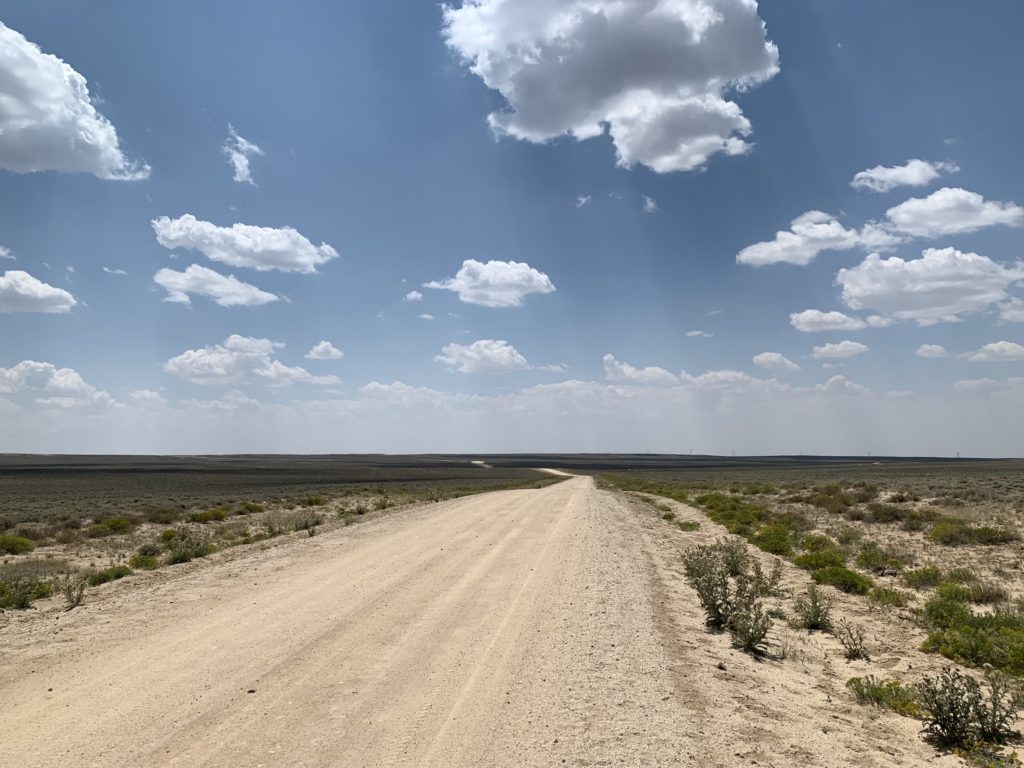
Writing climate obituaries for the natural world
One substantial limitation of our Palau study was the absence of pre-impact data. As a result, we couldn’t measure how the bleaching affected coral abundance and composition. Ecological monitoring isn’t always exciting, but it’s proved crucial to quantifying climate change impacts. Scientists working in all kinds of terrestrial and aquatic habitats revisit their field sites annually to track changes in species abundances. This usually means counting, photographing, or otherwise recording population densities in dozens or hundreds of plots scattered across multiple sites. All that data is then entered into spreadsheets, archived, and often shared with other researchers.
After graduating from Brown with my PhD, I got involved in reef monitoring, first in Mexico, and later in Belize. At the time, I didn’t expect much to change (at least in the short term). But within five years, we were already documenting mass die-offs of some of the most abundant and ecologically important coral species on Caribbean reefs. In 2000 I had tagged several hundred colonies of the massive boulder coral Orbicella for a demographic study. By 2005 nearly all were dead. Until then, the mass-bleaching I’d experienced had been of fast-growing, short-lived, weedy species that could recover within a decade or so. But these Orbicella colonies — all at least a meter or two in diameter — were centuries old. These populations weren’t just affected; they were nearly extirpated and would take many human lifetimes to recover.
The loss of these and other ancient organisms is probably what affects me the most. These impacts are nearly irreversible. A lot like clearcutting an old-growth forest. The skeletons of these massive corals are still there and probably will be for decades. Now they are overgrown by the weedy species that have come to dominate Caribbean coral reefs. For now, this is the state of a lot of the dying conifer forests I rode through. The standing dead trunks of the trees remain — at least for now until they fall over or burn.

Aspen provides a wakeup call
My five-week bike trip ended in Aspen, Colorado. My daughter, Mazarine, had joined me on the trail for the final few days. We rode across some of Colorado’s highest peaks and through lush alpine valleys. We saw moose grazing next to clear mountain streams and countless meadows blanketed by wildflowers. We were chirped at by marmots and pikas in boulder fields, and on the last night, we camped next to a shallow alpine lake at 12,400 feet, just below the final pass we’d cross the next morning.
Aspen is one of the world’s richest and most exclusive communities. On the way into town, we rode by the airport and gawked at the dozens of private jets lined up on the runway. Although the sky was crystal clear the last week of trip, when we flew out the next day, smoke had enveloped the area. We couldn’t see the hillsides or mountains adjacent to the airport and our takeoff was delayed due to poor visibility. All of this was an abrupt reminder to bring home; these climate-fueled conditions are real, they’re getting worse, and we still don’t truly understand how big a threat this is to our homes, our communities, our economy, our health, and nearly every aspect of our lives.
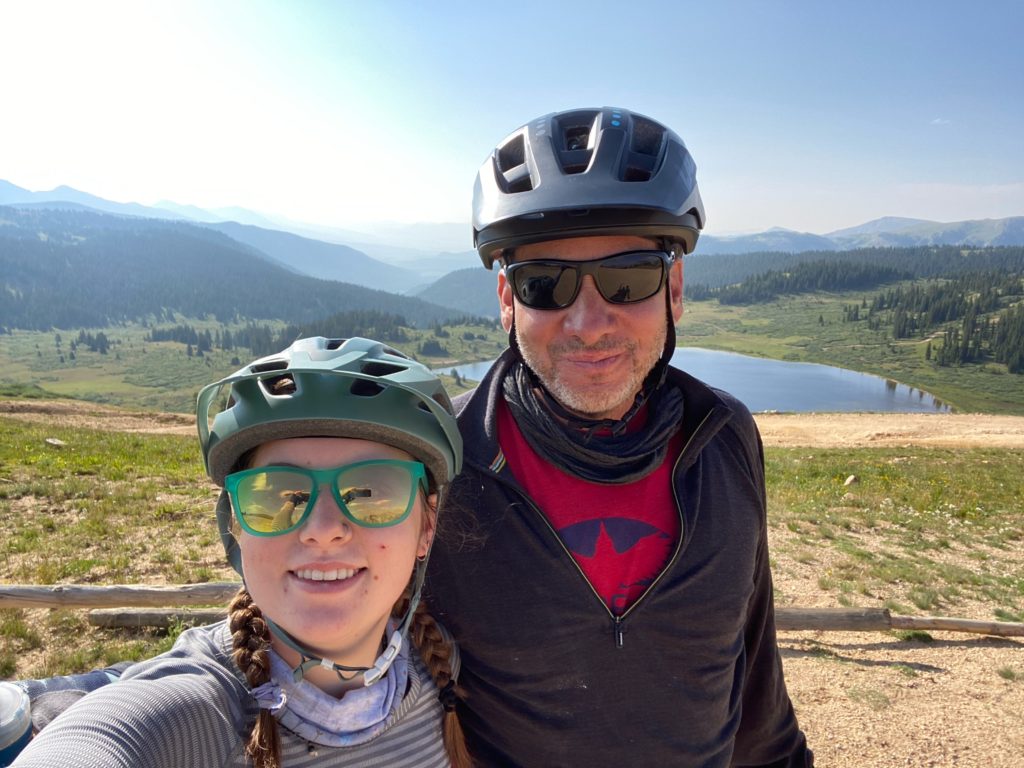
What to do? Eating less beef, flying and driving less, and riding our bikes more can’t hurt and could help. But the problem is far bigger than that. We need to begin a structural transformation of the nation — of our transportation and energy systems, of our housing economy and healthcare system, of our management and protection of ecosystems, and most of all, of our political systems. We need to start now and reduce our greenhouse gas emissions dramatically in the coming years and decades. In truth, we needed to start decades ago.
Will we do all this and limit the warming to around 3.5 degree Fahrenheit? (So far, we’ve warmed the planet by around 1.8 degree Fahrenheit or 1 degree Celsius.) I have no idea how to assess our chances, but honestly, I wouldn’t bet on it. I’m going to continue to do what I can to increase our odds, but I’m also going to be doing a lot more bikepacking and exploring of our world. Despite climate change and countless other environmental problems, there’s still so much wonder and natural beauty out there. So much left to marvel at and to protect. And It’s good to be reminded of that.
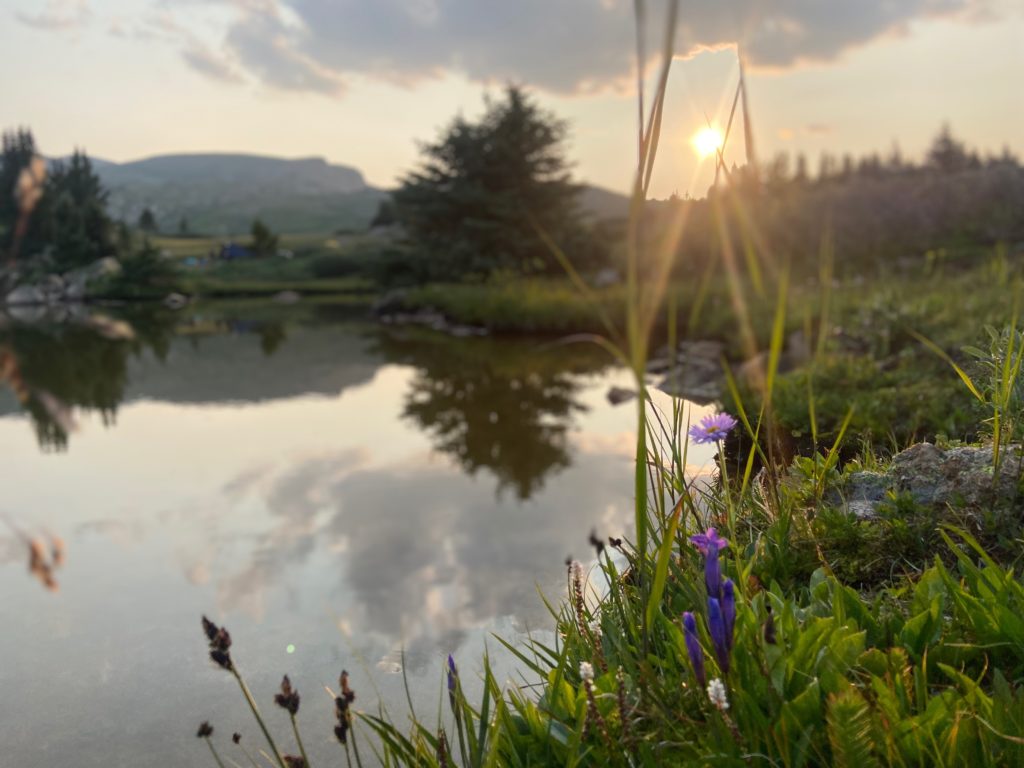
References
- Atwoli L, Baqui AH, Benfield T, Bosurgi R, Godlee F, Hancocks S, et al. Editorial: Call for emergency action to limit global temperature increases, restore biodiversity, and protect health. annals. 2021; rcsann.2021.0268. doi:10.1308/rcsann.2021.0268
- Kaplan S, Ba Tran A. Nearly 1 in 3 Americans experienced a weather disaster this summer. The Washington Post. 4 Sep 2021. Available: https://www.washingtonpost.com/climate-environment/2021/09/04/climate-disaster-hurricane-ida/
- Raffa KF, Aukema BH, Bentz BJ, Carroll AL, Hicke JA, Turner MG, et al. Cross-scale Drivers of Natural Disturbances Prone to Anthropogenic Amplification: The Dynamics of Bark Beetle Eruptions. BioScience. 2008;58: 501–517. doi:10.1641/B580607
- Andrus RA, Chai RK, Harvey BJ, Rodman KC, Veblen TT. Increasing rates of subalpine tree mortality linked to warmer and drier summers. Battipaglia G, editor. J Ecol. 2021;109: 2203–2218. doi:10.1111/1365-2745.13634
- Bruno JF, Siddon CE, Witman JD, Colin PL, Toscano MA. El Niño related coral bleaching in Palau, Western Caroline Islands. Coral Reefs. 2001;20: 127–136.
- Wilkinson CR. The 1997-1998 mass bleaching event around the world. Unpublished Report. 1998.
- Clayton S. Mental health risk and resilience among climate scientists. Nature Clim Change. 2018;8: 260–261. doi:10.1038/s41558-018-0123-z
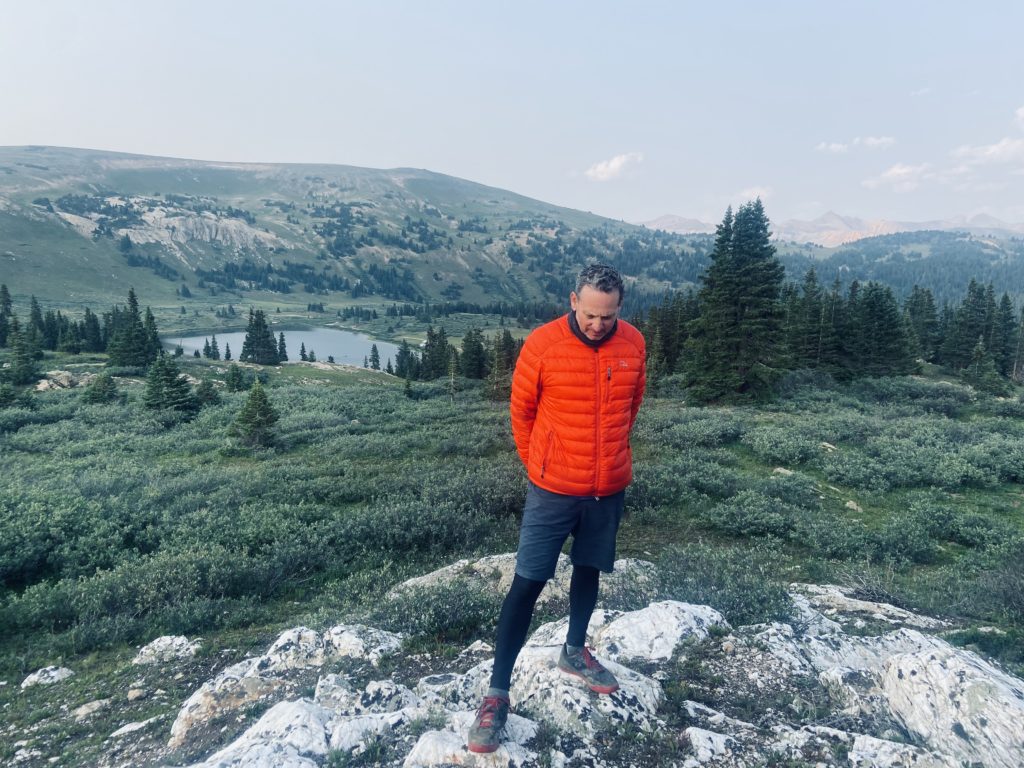
Notes and Gratitude: This piece is a draft of an eventual book chapter for an anthology of first person stories by climate scientists edited by Wendy Bruere. I want to thank Wendy, Raquel Harris, and Mazarine Bruno for their feedback on my text. The final three images are by Mazarine (Mazzy). All the others are by me (John). I rode about 1,300 miles on this trip over five weeks, and countless people showed me kindness and gave me assistance. That’s one of the best things about these trips across the earth; you inevitably come to rely on other people and inevitably, they surprise you with their kindness and generosity. Some fed us, gave us directions, allowed us to camp on their land, or just shared their time and stories. During the trip, I rode across the ancestral lands of numerous native tribes including the Blackfoot, Crow, Cheyenne, Arapaho, Eastern Shoshone, and Ute.

Leave a Reply